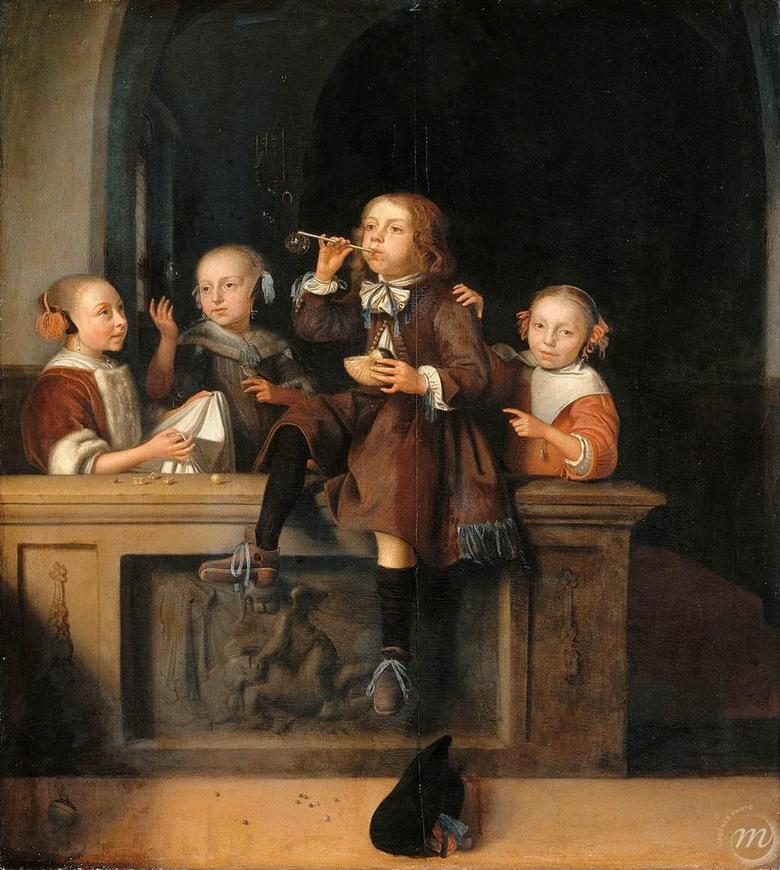The care taken in creating this painting reflects one of the characteristics of the famous Leiden School. This is also evident in the precise choice of colours, particularly the browns, coppers and reds of the clothing, enhanced by the brilliance of the blue ribbons.
We witness a wonderful, intimate scene where, under the arcade of an arched window, children are having fun. The little girl on the left is playing knucklebones while a young boy, sitting on a low wall decorated with a bas-relief, is blowing soap bubbles. The little girl on the right looks at us and points at him, perhaps to remind us of the symbolic, moralising value of soap bubbles, namely the ephemeral existence of man like that of a soap bubble.
The marbles, spinning top and knucklebones, made at the time with real bones, are other symbols of vanity, which remind us of the ephemeral side of the world of childhood and its earthly pleasures.
Detail 1 : Chardin was passionate about depicting children. Here, a young boy has pushed his books aside to observe the rotation of his “teetotum”, a sort of spinning top. (Boy with a spinning top, Jean-Siméon Chardin, Paris, Louvre Museum)
Detail 2 : Like Pieter Cornelisz van Slingeland, Frans van Mieris the Elder was a student of Gerrit Dou. A painter from the Leiden school, he also adopted a smooth, precious technique in this evocation of the fragile nature of existence. (A boy blowing soap bubbles, Frans van Mieris the Elder, The Hague, Mauritshuis Royal Picture Cabinet).
Inv. P 289

The care taken in creating this painting reflects one of the characteristics of the famous Leiden School. This is also evident in the precise choice of colours, particularly the browns, coppers and reds of the clothing, enhanced by the brilliance of the blue ribbons.
We witness a wonderful, intimate scene where, under the arcade of an arched window, children are having fun. The little girl on the left is playing knucklebones while a young boy, sitting on a low wall decorated with a bas-relief, is blowing soap bubbles. The little girl on the right looks at us and points at him, perhaps to remind us of the symbolic, moralising value of soap bubbles, namely the ephemeral existence of man like that of a soap bubble.
The marbles, spinning top and knucklebones, made at the time with real bones, are other symbols of vanity, which remind us of the ephemeral side of the world of childhood and its earthly pleasures.
Detail 1 : Chardin was passionate about depicting children. Here, a young boy has pushed his books aside to observe the rotation of his “teetotum”, a sort of spinning top. (Boy with a spinning top, Jean-Siméon Chardin, Paris, Louvre Museum)
Detail 2 : Like Pieter Cornelisz van Slingeland, Frans van Mieris the Elder was a student of Gerrit Dou. A painter from the Leiden school, he also adopted a smooth, precious technique in this evocation of the fragile nature of existence. (A boy blowing soap bubbles, Frans van Mieris the Elder, The Hague, Mauritshuis Royal Picture Cabinet).
Inv. P 289